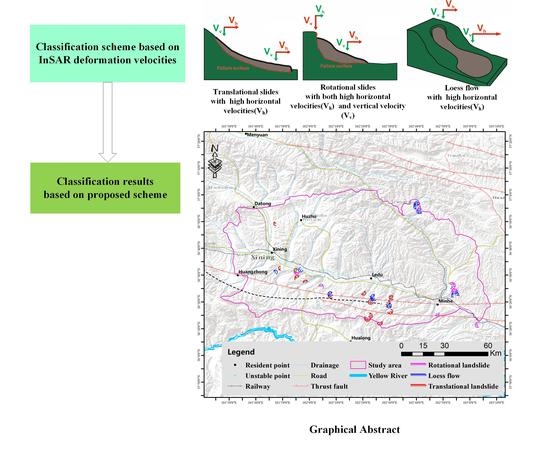Regional Recognition and Classification of Active Loess Landslides Using Two-Dimensional Deformation Derived from Sentinel-1 Interferometric Radar Data
Abstract
:1. Introduction
2. Study Area
3. Dataset and Methodology
3.1. Dataset
3.2. DInSAR Processing Chain
3.3. UAV Survey and Data Processing
3.4. Classification Scheme of Loess Landslide
- Translational slides: the major displacement direction is conventionally horizontal, the characteristic deformation rate is low, with slow and intermittent movements; the horizontal deformation is typically dominant, much higher than the vertical one, along the whole landslide body. This sort of slide can be usually distributed in slope sectors characterized by gentle topographic gradient.
- Rotational slides: these events are characterized by a balance between horizontal and vertical displacements, however, their distribution in the landslide body is different. The vertical movement is located mostly in the upper part of slopes, whilst the rest of the landslide moves with a direction usually parallel to the slope. This failure is prone to develop in steep slopes with arc-shaped rupture surface under unsaturated loess layers. Field investigation shows that many cracks can be often seen in the crown and shear deformation area, representing the rapid, and even surge sliding velocities. Besides, a large number of fissures, typically present in the middle or toe part of the slope, demonstrate that the deformation direction changes from vertical to horizontal.
- Loess Flows: theoretically, horizontal velocities are predominant, even though a vertical component is present, depending on the steepness of the slope; generally, flows are characterized by a more rapid motion with a very short time interval. However, differently from transitional and rotational slides, loess rapid flows are difficult to detect by single deformation characteristics, since abrupt movement cannot be detected by satellite imagery, therefore here only slow flows or intermittent phases are considered.
4. Results
4.1. Mean Deformation Velocities along the LOS
4.2. Horizontal and Vertical Deformation Velocities Distribution
4.3. Classification Scheme Validation
4.3.1. Translational Slide
4.3.2. Rotational Slide
4.3.3. Loess Flow
5. Discussion
6. Conclusions
Author Contributions
Funding
Acknowledgments
Conflicts of Interest
Appendix A

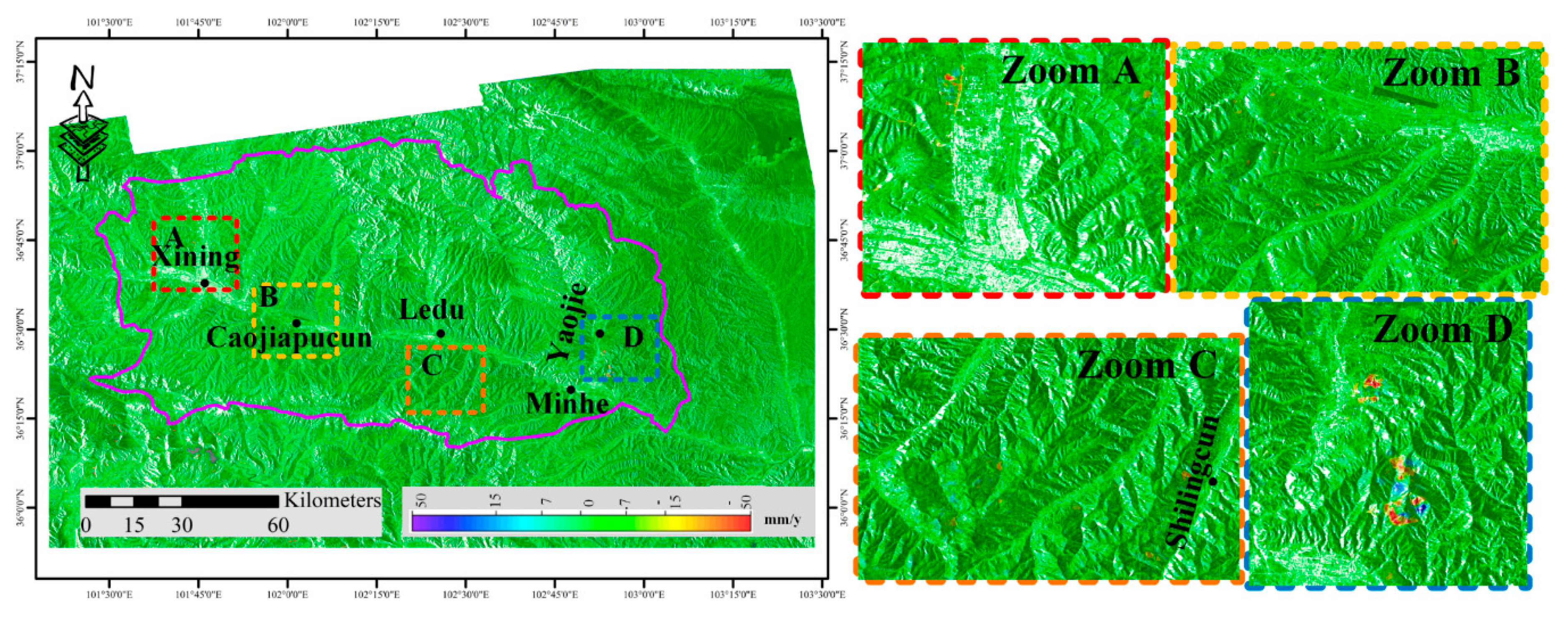
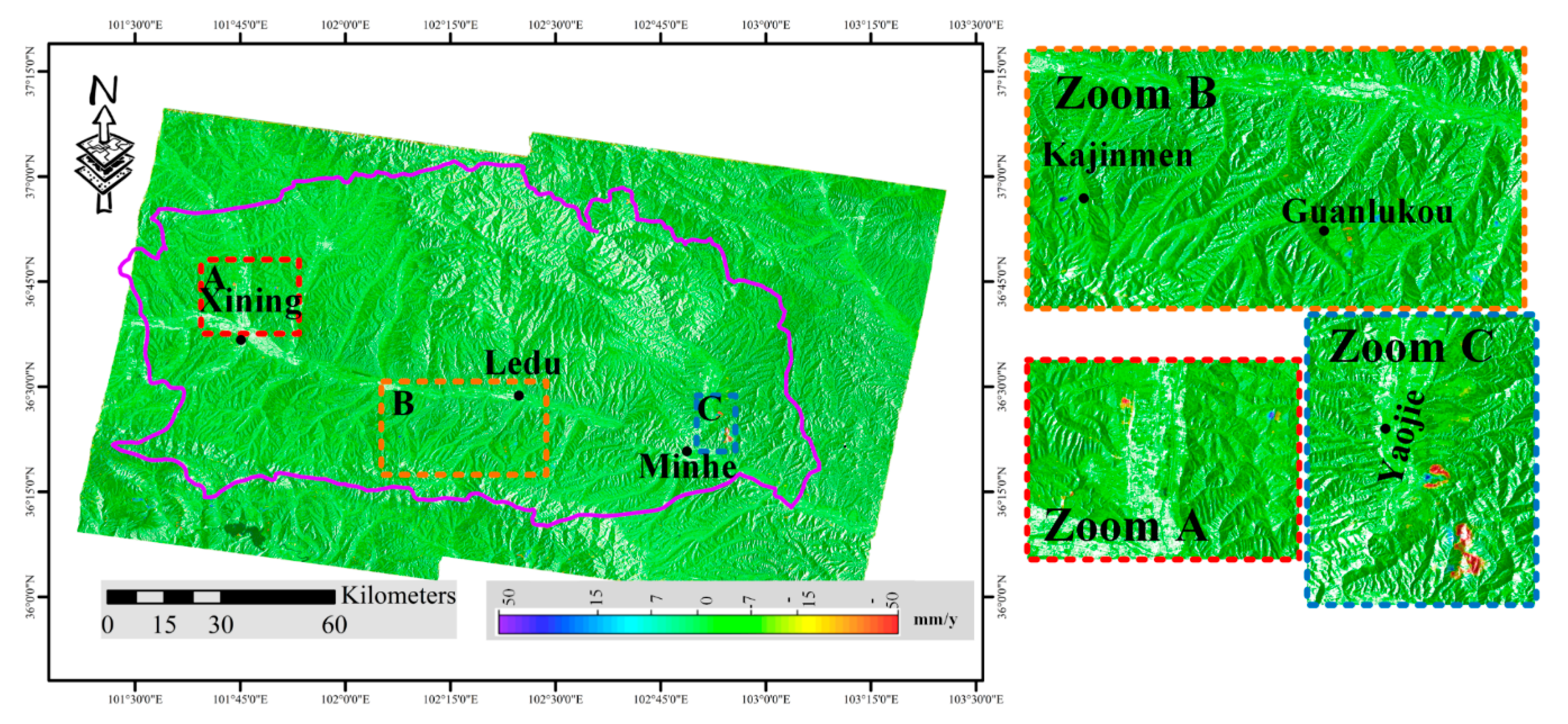
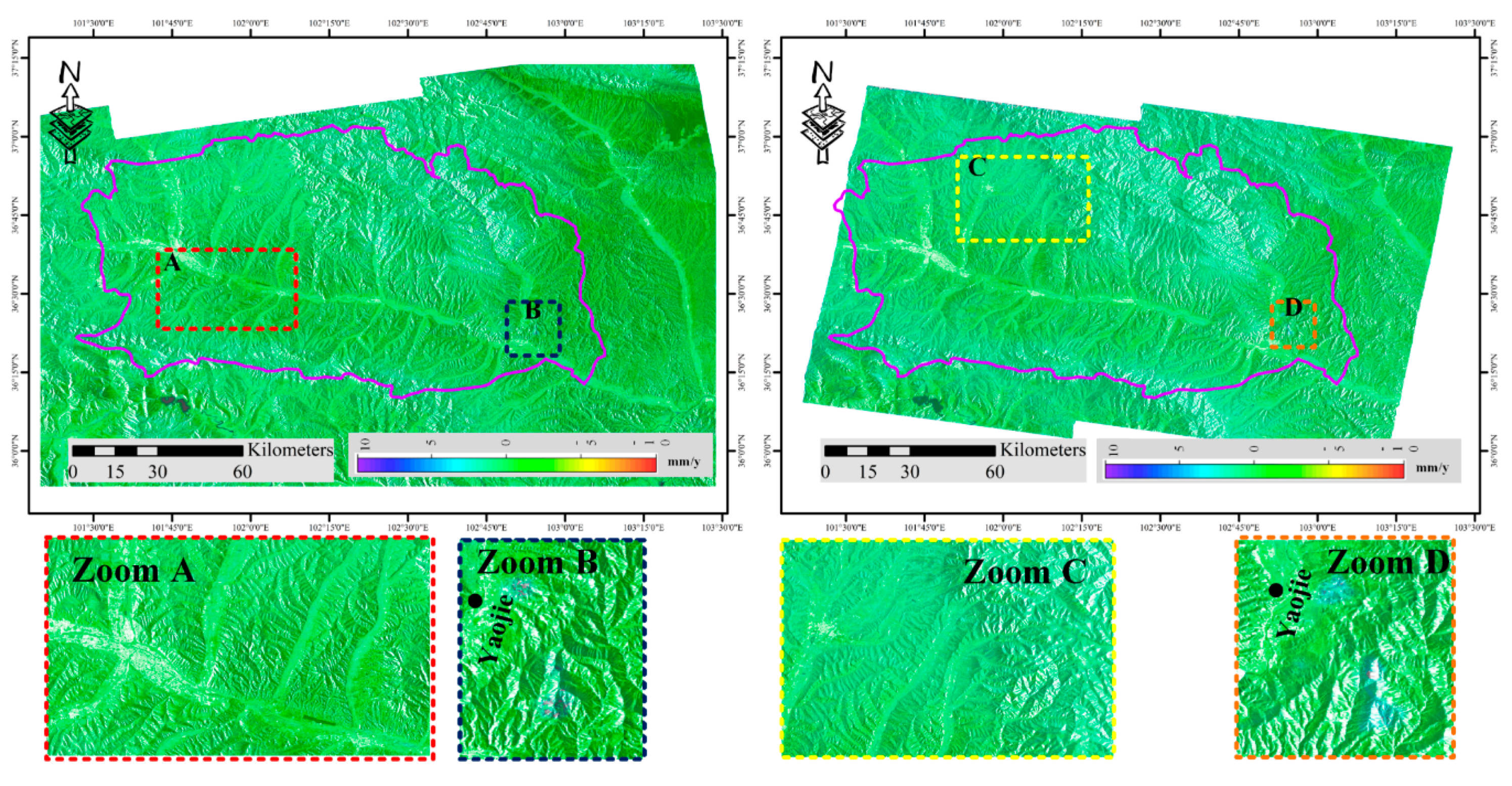
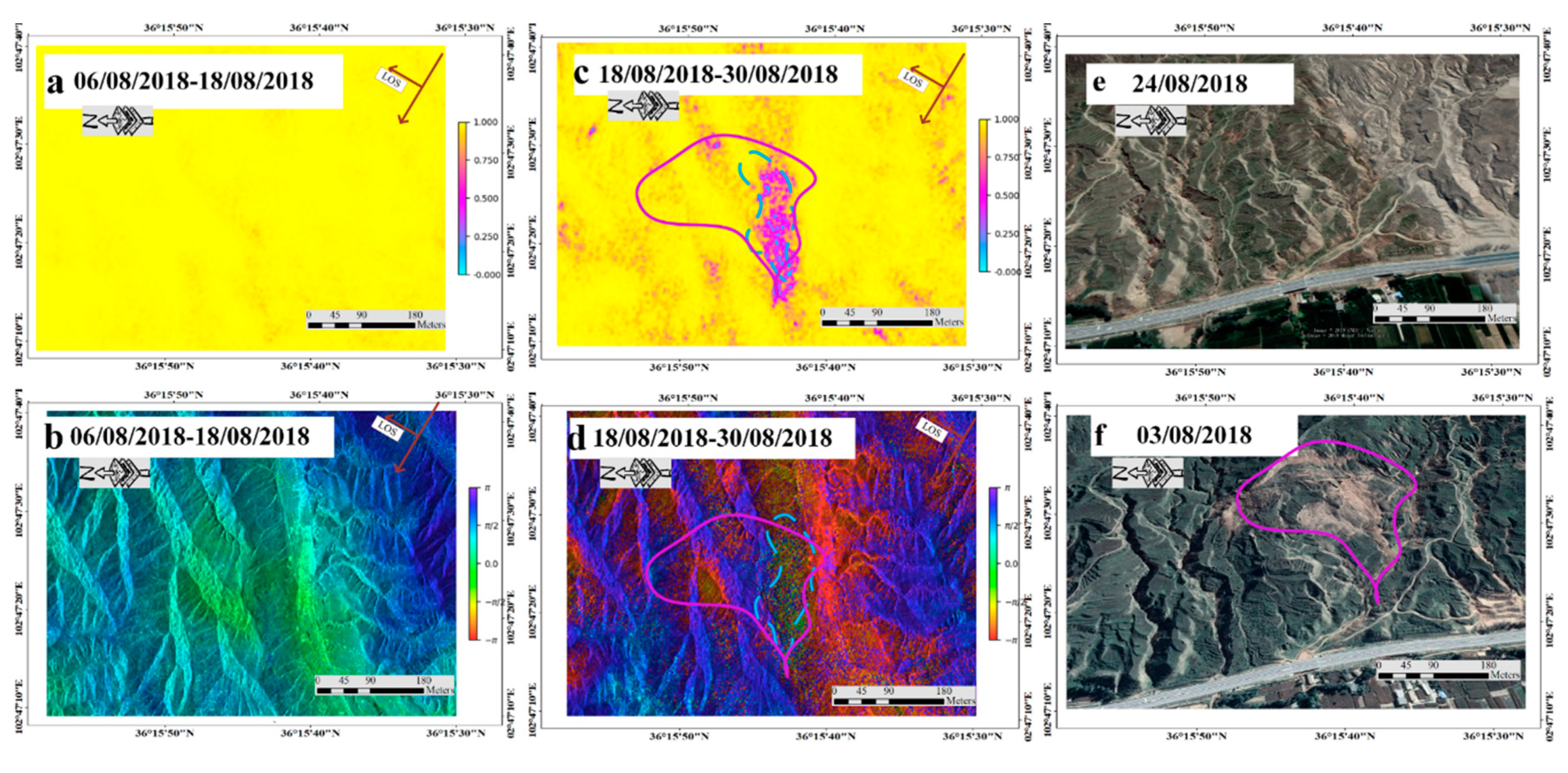
References
- Peng, J.; Wang, S.; Wang, Q.; Zhuang, J.; Huang, W. Distribution and genetic types of loess landslides in China. J. Asian Earth Sci. 2019, 170, 329–350. [Google Scholar] [CrossRef]
- Wieczorek, G.F.; Glade, T.; Jakob, T.; Hungr, T. Climatic Factors Influencing Occurrence of Debris Flows. In Debris-Flow Hazards and Related Phenomena; Springer: Berlin/Heidelberg, Germany, 2005; pp. 325–362. [Google Scholar] [CrossRef]
- Pepe, G.; Mandarino, A.; Raso, E.; Cevasco, A.; Firpo, M.; Casagli, N. Extreme flood and landslides triggered in the Arroscia Valley (Liguria Region, Northwestern Italy) during the November 2016 rainfall event. In Proceedings of the IAEG/AEG Annual Meeting Proceedings, San Francisco, CA, USA, 26 August 2018; Volume 1, pp. 171–175. [Google Scholar]
- Reinman, S. Intergovernmental panel on climate change (IPCC). Ref. Rev. 2012, 26, 41–42. [Google Scholar] [CrossRef]
- Gariano, S.L.; Guzzetti, F. Landslides in a changing climate. Earth Sci. Rev. 2016, 162, 227–252. [Google Scholar] [CrossRef] [Green Version]
- Gregory, S. Holocene Book Reviews: Climate Change 1995: The Science of Climate Change; Houghton, J.T., Meiro Filho, L.G., Callander, B.A., Harris, N., Kattenberg, A., Maskell, K., Eds.; Cambridge University Press: Cambridge, UK, 1997; p. 125. [Google Scholar] [CrossRef]
- Myhre, G.; Alterskjær, K.; Stjern, C.W.; Hodnebrog, Ø.; Marelle, L.; Samset, B.H.; Sillmann, J.; Schaller, N.; Fischer, E.; Schulz, M.; et al. Frequency of extreme precipitation increases extensively with event rareness under global warming. Sci. Rep. UK 2019, 9, 16063. [Google Scholar] [CrossRef] [Green Version]
- Yin, Z.; Qin, X.; Yin, Y.; Zhao, W.; Wei, G. Landslide developmental characteristics and response to climate change since the last glacial in the upper reaches of the yellow river, NE Tibetan plateau. Acta. Geol. Sin. Engl. 2014, 2, 635–646. [Google Scholar] [CrossRef]
- Keefer, D.K.; Larsen, M.C. Assessing landslide hazards. Science 2007, 316, 1136–1138. [Google Scholar] [CrossRef]
- Wang, J.J.; Liang, Y.; Zhang, H.P.; Wu, Y.; Lin, X. A loess landslide induced by excavation and rainfall. Landslides 2014, 11, 141–152. [Google Scholar] [CrossRef]
- Gudmundsson, S.; Gudmundsson, M.T.; Bjornsson, H.; Sigmundsson, F.; Rott, H.; Carstensen, J.M. Three-dimensional glacier surface motion maps at the Gjalp eruption site, Iceland, inferred from combining InSAR and other ice-displacement data. Ann. Glaciol. 2002, 34, 315–322. [Google Scholar] [CrossRef] [Green Version]
- Di Martire, D.; Paci, M.; Confuorto, P.; Costablie, S.; Guastaferro, F.; Verta, A.; Calcaterra, D. A nation-wide system for landslide mapping and risk management in Italy: The second Not-ordinary Plan of Environmental Remote Sensing. Int. J. Appl. Earth Obs. Geoinf. 2017, 63, 143–157. [Google Scholar] [CrossRef]
- Fan, X.; Xu, Q.; Scaringi, G.; Li, S.; Peng, D. A chemo-mechanical insight into the failure mechanism of frequently occurred landslides in the Loess Plateau, Gansu Province, China. Eng. Geol. 2017, 228, 337–345. [Google Scholar] [CrossRef]
- Li, T.; Wang, C.; Li, P. Loess Deposit and Loess Landslides on the Chinese Loess Plateau, Progress of Geo-Disaster Mitigation Technology in Asia; Springer: Berlin/Heidelberg, Germany, 2013; pp. 235–261. [Google Scholar] [CrossRef]
- Wiemer, G.; Moernaut, J.; Stark, N.; Kempf, P.; De Batist, M.; Pino, M.; Kopf, A. The role of sediment composition and behavior under dynamic loading conditions on slope failure initiation: A study of a subaqueous landslide in earthquake-prone South-Central Chile. Int. J. Earth Sci. 2015, 104, 1439–1457. [Google Scholar] [CrossRef]
- Zhuang, J.; Peng, J.; Zhu, X.; Li, W.; Ma, P.H.; Liu, T.M. Spatial distribution and susceptibility zoning of geohazards along the Silk Road, Xian-Lanzhou. Environ. Earth. Sci. 2016, 75, 711. [Google Scholar] [CrossRef]
- Ding, H.; Li, Y.; Yang, Y.; Jia, X. Origin and evolution of modern loess science–1824 to 1964. J. Asian Earth Sci. 2019, 170, 45–55. [Google Scholar] [CrossRef]
- Confuorto, P.; Di Martire, D.; Infante, D.; Novellino, R.P.; Calcaterra, D.; Ramondini, M. Monitoring of remedial works performance on landslide-affected areas through ground-and satellite-based techniques. Catena 2019, 178, 77–89. [Google Scholar] [CrossRef]
- Li, Z.; Shi, W.; Myint, S.W.; Lu, P.; Wang, Q. Semi-automated landslide inventory mapping from bitemporal aerial photographs using change detection and level set method. Remote Sens. Environ. 2016, 175, 215–230. [Google Scholar] [CrossRef]
- Li, B.; Feng, Z.; Wang, W.P. Characteristics of the Sanmen Formation clays and their relationship with loess landslides in the Guanzhong area, Shaanxi, China. Arab. J. Geosci. 2012, 8, 7831–7843. [Google Scholar] [CrossRef]
- Li, Y.; Mo, P. A unified landslide classification system for loess slopes: A critical review. Geomorphology 2019, 340, 67–83. [Google Scholar] [CrossRef]
- Sun, W.; Tian, Y.; Mu, X.; Zhai, J.; Gao, P.; Zhao, G. Loess landslide inventory map based on GF-1 satellite imagery. Remote Sens. 2017, 9, 314. [Google Scholar] [CrossRef] [Green Version]
- Peng, D.; Xu, Q.; Liu, F.; He, Y.; Zhang, S.; Qi, X.; Zhang, X. Distribution and failure modes of the landslides in Heitai terrace, China. Eng. Geol. 2018, 236, 97–110. [Google Scholar] [CrossRef]
- Scaioni, M.; Longoni, L.; Melillo, V.; Papini, M. Remote sensing for landslide investigations: An overview of recent achievements and perspectives. Remote Sens. 2014, 6, 9600–9652. [Google Scholar] [CrossRef] [Green Version]
- Zhao, C.; Kang, Y.; Zhang, Q.; Lu, Z.; Li, B. Landslide identification and monitoring along the Jinsha River catchment (Wudongde reservoir area), China, using the InSAR method. Remote Sens. 2018, 10, 993. [Google Scholar] [CrossRef] [Green Version]
- Shi, X.; Yang, C.; Zhang, L.; Jiang, H.; Liao, M.; Zhang, L.; Liu, X. Science of the Total Environment Mapping and characterizing displacements of active loess slopes along the upstream Yellow River with multi-temporal InSAR datasets. Sci. Total Environ. 2019, 674, 200–210. [Google Scholar] [CrossRef] [PubMed]
- Varnes, D.J. Slope movement types and processes, Landslides: Analyses and Control. Trans. Res. Bd. Spec. Rep. 1978, 176, 11–33. [Google Scholar]
- Tu, X.B.; Kwong, A.K.L.; Dai, F.C.; Tham, L.G.; Min, H. Field monitoring of rainfall in- filtration in a loess slope and analysis of failure mechanism of rainfall-induced land- slides. Eng. Geol. 2009, 105, 134–150. [Google Scholar] [CrossRef]
- Picarelli, L. Discussion on “A rapid loess flowslide triggered by irrigation in China” by D.; Zhang, G.; Wang, C.; Luo, J. Chen, and Y. Zhou. Landslides 2010, 7, 203–205. [Google Scholar] [CrossRef]
- Raspini, F.; Cigna, F.; Moretti, S. Multi-temporal mapping of land subsidence at basin scale exploiting persistent scatterer interferometry: Case study of Gioia Tauro plain (Italy). J. Maps. 2012, 8, 514–524. [Google Scholar] [CrossRef] [Green Version]
- Fuhrmann, T.; Garthwaite, M.C. Resolving three-dimensional surface motion with InSAR: Constraints from multi-geometry data fusion. Remote Sens. 2019, 11, 241. [Google Scholar] [CrossRef] [Green Version]
- Tofani, V.; Raspini, F.; Catani, F.; Casagli, N. Persistent Scatterer Interferometry (PSI) technique for landslide characterization and monitoring. Remote Sens. 2013, 5, 1045–1065. [Google Scholar] [CrossRef] [Green Version]
- Solari, L.; Raspini, F.; Del Soldato, M.; Bianchini, S.; Ciampalini, A.; Ferrigno, F.; Casagli, N. Satellite radar data for back-analyzing a landslide event: The Ponzano (Central Italy) case study. Landslides 2018, 15, 773–782. [Google Scholar] [CrossRef] [Green Version]
- De Luca, D.L.; Versace, P. A comprehensive framework for empirical modeling of landslides induced by rainfall: The Generalized FLaIR Model (GFM). Landslides 2017, 14, 1009–1030. [Google Scholar] [CrossRef]
- Infante, D.; Di Martire, D.; Confuorto, P.; Tessitore, S.; Tòmas, R.; Calcaterra, D.; Ramondini, M. Assessment of building behavior in slow-moving landslide-affected areas through DInSAR data and structural analysis. Eng. Struct. 2019, 199. [Google Scholar] [CrossRef] [Green Version]
- Tomás, R.; Pagán, J.I.; Navarro, J.A.; Cano, M.; Pastor, J.L.; Riquelme, A.; Casagli, N. Semi-automatic identification and pre-screening of geological-geotechnical deformational processes using persistent scatterer interferometry datasets. Remote Sens. 2019, 11, 1675. [Google Scholar] [CrossRef] [Green Version]
- Fialko, Y.; Simons, M.; Agnew, D. The complete (3-D) surface displacement field in the epicentral area of the 1999 Mw 7.1 Hector Mine Earthquake, California, from space geodetic observations. Geophys. Res. Lett. 2001, 28, 3063–3066. [Google Scholar] [CrossRef] [Green Version]
- Hu, J.; Li, Z.W.; Ding, X.L.; Hu, J.J.; Zhang, L.; Sun, Q. Resolving three-dimensional surface displacements from InSAR measurements: A review. Earth Sci. Rev. 2014, 133, 1–17. [Google Scholar] [CrossRef]
- Vollrath, A.; Zucca, F.; Bekaert, D.; Bonforte, A.; Guglielmino, F.; Hooper, A.J.; Stramondo, S. Decomposing DInSAR time-series into 3-D in combination with GPS in the case of low strain rates: An application to the Hyblean Plateau, Sicily, Italy. Remote Sens. 2017, 9, 33. [Google Scholar] [CrossRef] [Green Version]
- Hu, J.; Li, Z.W.; Zhu, J.J.; Ren, X.C.; Ding, X.L. Inferring three-dimensional surface dis- placement field by combining SAR interferometric phase and amplitude information of ascending and descending orbits. Sci. China Earth Sci. 2010, 53, 550–560. [Google Scholar] [CrossRef]
- Vandenberghe, J.; Wang, X.; Lu, H. Differential impact of small-scaled tectonic movements on fluvial morphology and sedimentology (the Huang Shui catchment, NE Tibet Plateau). Geomorphology 2011, 134, 171–185. [Google Scholar] [CrossRef]
- Clark, M.K.; Royden, L.H.; Whipple, K.X.; Burchfiel, B.C.; Zhang, X.; Tang, W. Use of a regional, relict landscape to measure vertical deformation of the eastern Tibetan Plateau. Geophys. Res. Lett. 2006, 111, 1–23. [Google Scholar] [CrossRef] [Green Version]
- Qinghai Bureau of Geology and Mineral Resources. Regional Geology of the Qinghai Province; Geology Publication House: Beijing, China, 1991; p. 662. (In chinese) [Google Scholar]
- Massonnet, D.; Feigl, K.L. Radar interferometry and its application to changes in the Earth’s surface. Rev. Geophys. 1998, 36, 441–500. [Google Scholar] [CrossRef] [Green Version]
- Morelli, S.; Tanteri, L.; Raspini, F.; Tofani, V.; Frodella, W.; Rossi, G.; Ciampalini, A. Spaceborne, UAV and ground-based remote sensing techniques for landslide mapping, monitoring and early warning. Geoenviron. Disasters 2017, 4, 9. [Google Scholar] [CrossRef]
- Ferretti, A.; Prati, C.; Rocca, F. Permanent scatterers in SAR interferometry. IEEE Trans. Geosci. Remote. 2001, 39, 8–20. [Google Scholar] [CrossRef]
- Berardino, P.; Fornaro, G.; Lanari, R.; Sansosti, E. A new algorithm for surface deformation monitoring based on small baseline differential SAR interferograms. IEEE Trans. Geosci. Remote. 2002, 40, 2375–2383. [Google Scholar] [CrossRef] [Green Version]
- Duro, J.; Inglada, J.; Closa, J.; Adam, N.; Arnaud, A. High Resolution Differential Interferometry Using Times Series of ERS and Envisat SAR Data; FRINGE Workshop: Frascati, Italy, 2003; pp. 1–5. [Google Scholar]
- Hooper, A.; Segall, P.; Zebker, H. Persistent Scatterer InSAR for crustal deformation analysis, with application to Volcan Alcedo, Galapagos. J. Geophys. Res. 2007, 112, B07407. [Google Scholar] [CrossRef] [Green Version]
- Mora, O.; Mallorqui, J.J.; Broquetas, A. Linear and nonlinear terrain deformation maps from a reduced set of interferometric SAR images. IEEE Trans. Geosci. Remote. 2003, 41, 2243–2253. [Google Scholar] [CrossRef]
- Ferretti, A.; Fumagalli, A.; Novali, F.; Prati, C.; Rocca, F.; Rucci, A. A new algorithm for processing interferometric data-stacks: SqueeSAR. IEEE Trans. Geosci. Remote. 2011, 49, 3460–3470. [Google Scholar] [CrossRef]
- Intrieri, E.; Raspini, F.; Fumagalli, A.; Lu, P.; Del Conte, S.; Farina, P.; Casagli, N. The Maoxian landslide as seen from space: Detecting precursors of failure with Sentinel-1 data. Landslides 2018, 15, 123–133. [Google Scholar] [CrossRef] [Green Version]
- Onn, F.; Zebker, H.A. Correction for interferometric synthetic aperture radar atmospheric phase artifacts using time series of zenith wet delay observations from a GPS network. Geophys. Res. 2006, 111, B09102. [Google Scholar] [CrossRef]
- Zhao, C.; Zhang, Q.; He, Y.; Peng, J.; Yang, C.; Kang, Y. Small-scale loess landslide monitoring with small baseline subsets interferometric synthetic aperture radar technique—case study of Xingyuan landslide, Shaanxi, China. J. Appl. Remote Sens. 2016, 10, 026030. [Google Scholar] [CrossRef] [Green Version]
- Liu, X.; Zhao, C.; Zhang, Q.; Yang, C.; Zhu, W. Heifangtai loess landslide type and failure mode analysis with ascending and descending Spot-mode TerraSAR-X datasets. Landslides 2020, 17, 205–215. [Google Scholar] [CrossRef] [Green Version]
- Xu, C.; Xu, X.W.; Shyu, J.B.H.; Gao, M.X.; Tan, X.B.; Ran, Y.K.; Zhang, W.J. Landslides triggered by the 20 April 2013 Lushan, China, Mw 6.6 earthquake from field investigations and preliminary analyses. Landslides 2015, 12, 365–385. [Google Scholar] [CrossRef]
- Carlà, T.; Tofani, V.; Lombardi, L.; Raspini, F.; Bianchini, S.; Bertolo, D.; Casagli, N. Combination of GNSS, satellite InSAR, and GBInSAR remote sensing monitoring to improve the understanding of a large landslide in high alpine environment. Geomorphology 2019, 335, 62–75. [Google Scholar] [CrossRef]
- Chen, G.; Meng, X.; Qiao, L.; Zhang, Y.; Wang, S.Y. Response of a loess landslide to rainfall: Observations from a field artificial rainfall experiment in Bailong River Basin, China. Landslides 2018, 15, 895–911. [Google Scholar] [CrossRef]
- Liu, Y.; Liao, M.S.; Shi, X.; Zhang, L.; Cunningham, C. Potential loess landslide deformation monitoring using L-band SAR interferometry. Geo-Spat. Inf. Sci. 2016, 19, 273–277. [Google Scholar] [CrossRef]
- Sun, Q.; Hu, J.; Zhang, L.; Ding, X.L. Towards slow-moving landslide monitoring by integrating multi-sensor InSAR time series datasets: The Zhouqu case study, China. Remote Sens. 2016, 8, 908. [Google Scholar] [CrossRef] [Green Version]








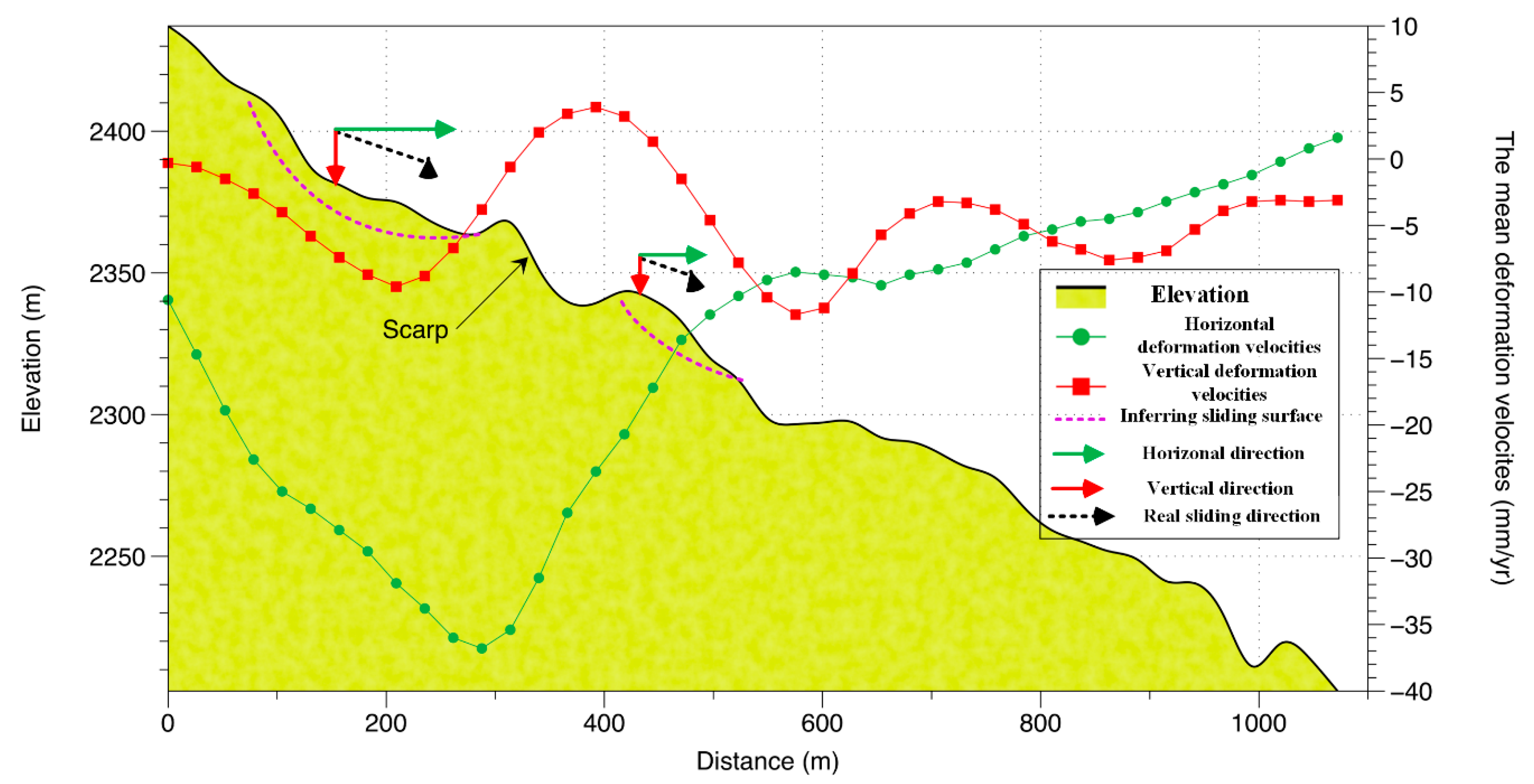


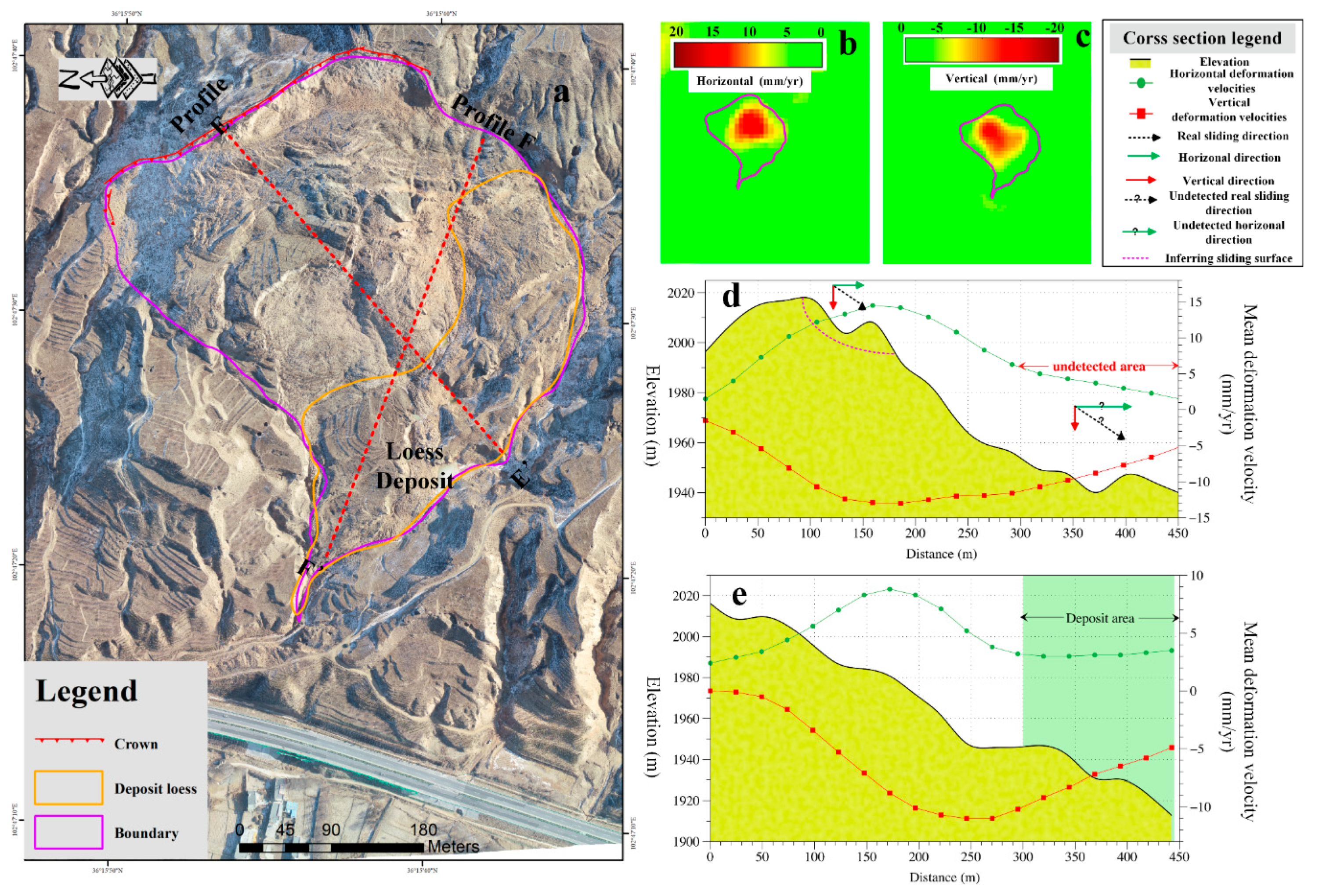
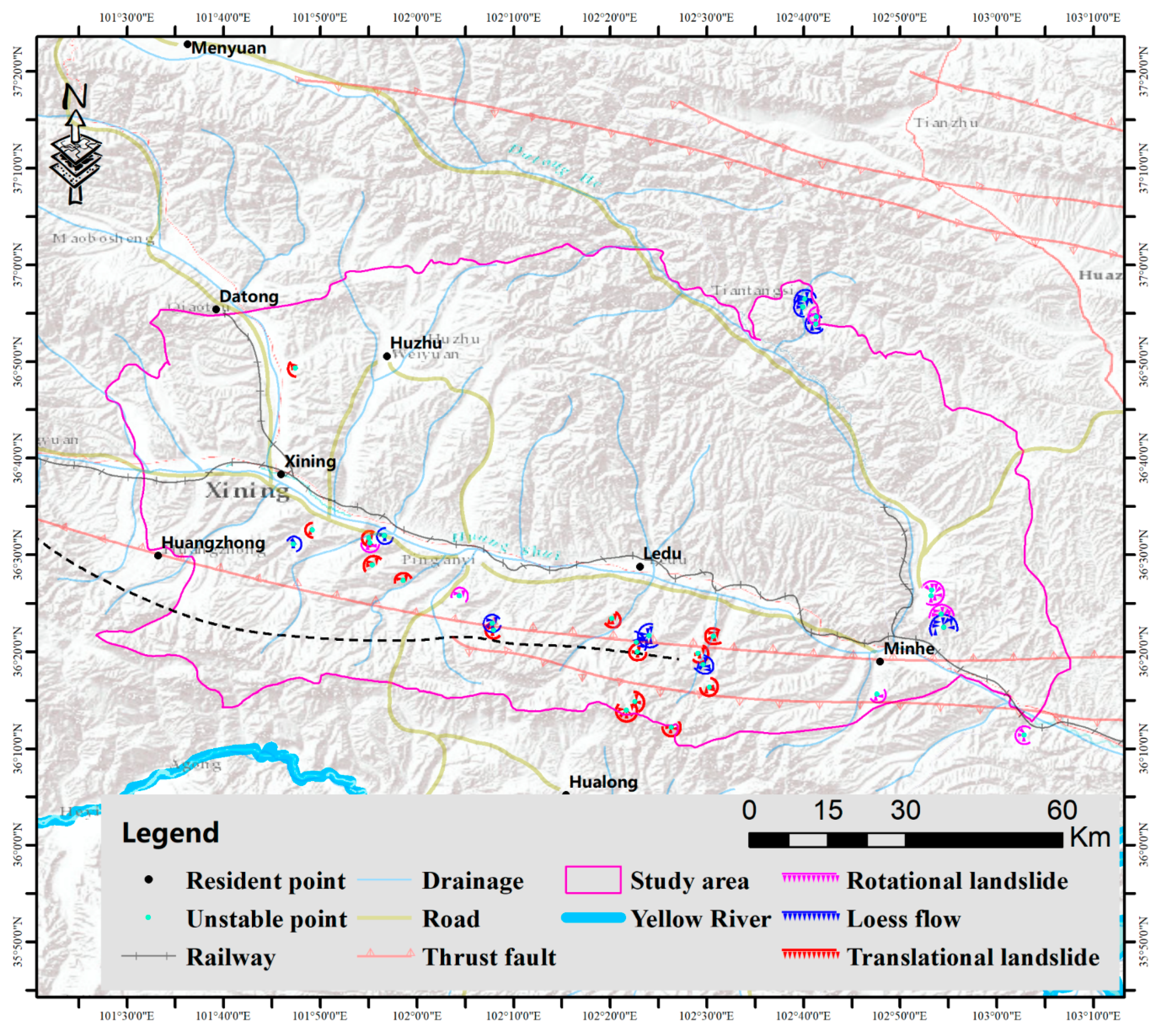
| Type | Major Movement Direction | Deformation Velocities | Deformation Location |
|---|---|---|---|
| Translational slides | H | High Vh | Whole landslide body |
| Rotational slides | V | High Vv, Vh, | Source area |
| Loess flow | H | High Vh | Parallel to the slope |
© 2020 by the authors. Licensee MDPI, Basel, Switzerland. This article is an open access article distributed under the terms and conditions of the Creative Commons Attribution (CC BY) license (http://creativecommons.org/licenses/by/4.0/).
Share and Cite
Meng, Q.; Confuorto, P.; Peng, Y.; Raspini, F.; Bianchini, S.; Han, S.; Liu, H.; Casagli, N. Regional Recognition and Classification of Active Loess Landslides Using Two-Dimensional Deformation Derived from Sentinel-1 Interferometric Radar Data. Remote Sens. 2020, 12, 1541. https://doi.org/10.3390/rs12101541
Meng Q, Confuorto P, Peng Y, Raspini F, Bianchini S, Han S, Liu H, Casagli N. Regional Recognition and Classification of Active Loess Landslides Using Two-Dimensional Deformation Derived from Sentinel-1 Interferometric Radar Data. Remote Sensing. 2020; 12(10):1541. https://doi.org/10.3390/rs12101541
Chicago/Turabian StyleMeng, Qingkai, Pierluigi Confuorto, Ying Peng, Federico Raspini, Silvia Bianchini, Shuai Han, Haocheng Liu, and Nicola Casagli. 2020. "Regional Recognition and Classification of Active Loess Landslides Using Two-Dimensional Deformation Derived from Sentinel-1 Interferometric Radar Data" Remote Sensing 12, no. 10: 1541. https://doi.org/10.3390/rs12101541
APA StyleMeng, Q., Confuorto, P., Peng, Y., Raspini, F., Bianchini, S., Han, S., Liu, H., & Casagli, N. (2020). Regional Recognition and Classification of Active Loess Landslides Using Two-Dimensional Deformation Derived from Sentinel-1 Interferometric Radar Data. Remote Sensing, 12(10), 1541. https://doi.org/10.3390/rs12101541






